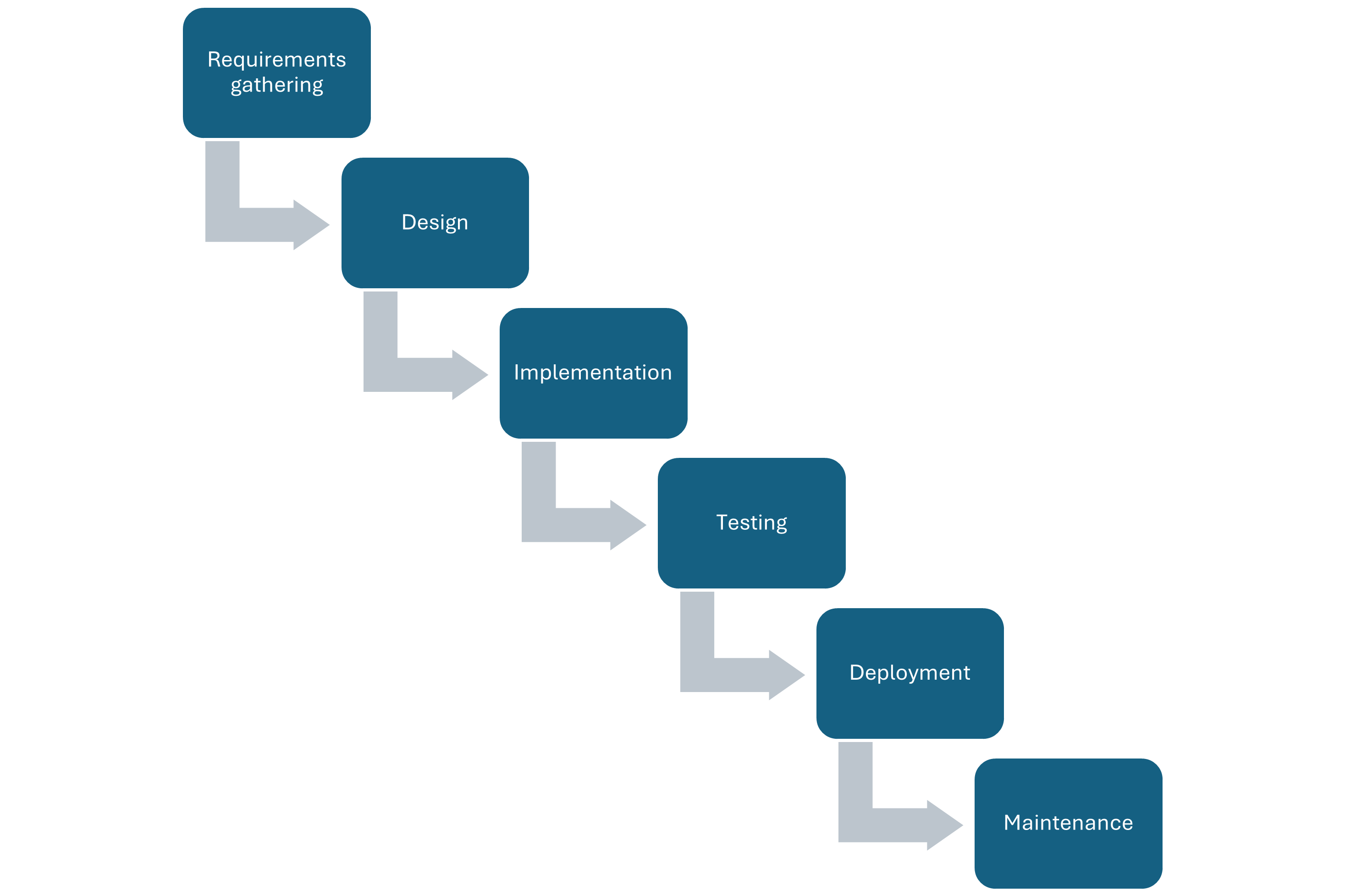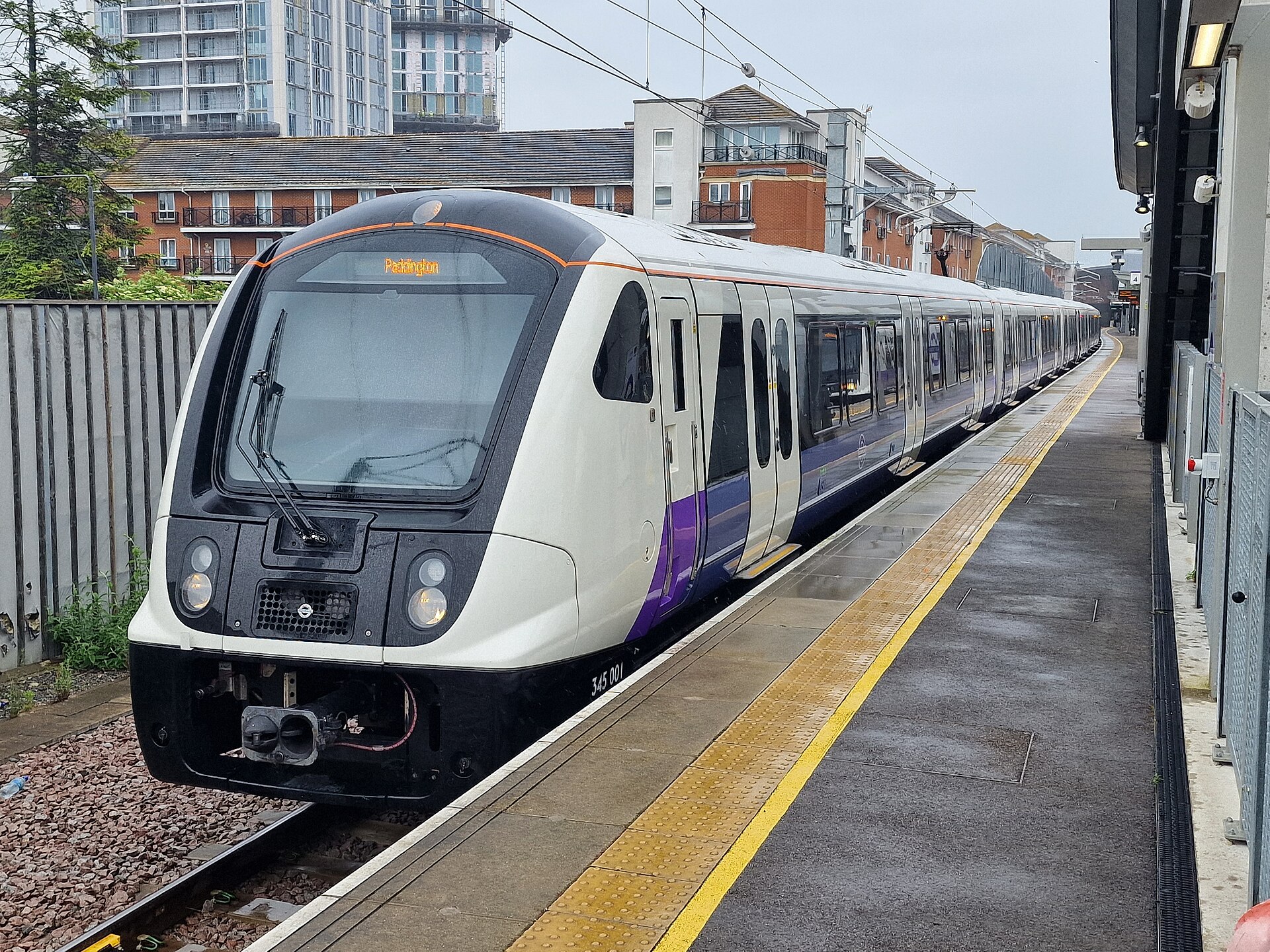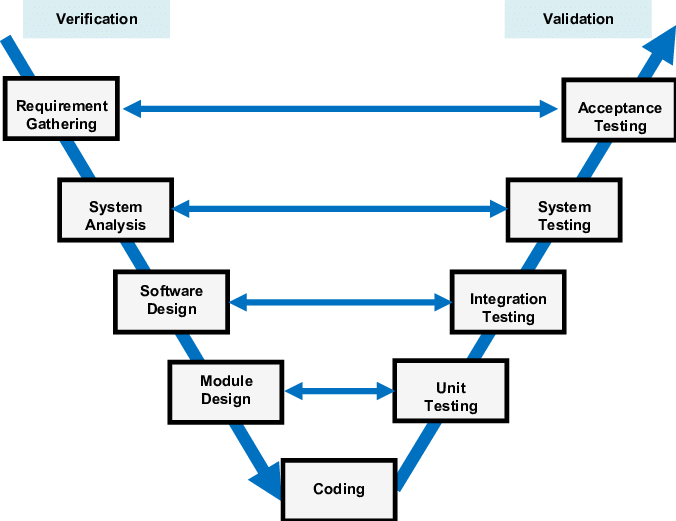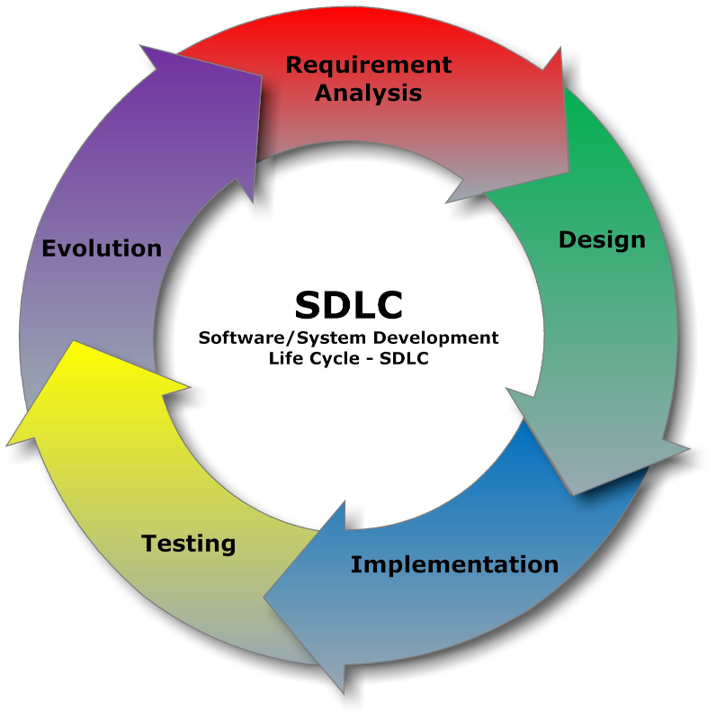1.2 Software Development Process and the Landscape of Approaches
Last updated on 2025-09-25 | Edit this page
Overview
Questions
- What are the main stages in a typical software development process?
- What are waterfall, iterative, and V-Model approaches to software development?
- What is Agile and how does it compare to project management?
- How do software development models compare and relate to project management frameworks?
Objectives
- Highlight the main stages in a software development process
- Order and describe the stages within a typical software development process and how these apply within waterfall and iterative approaches
- Summarise the V-Model approach to software development
- Describe how software development models compare and relate to project management frameworks (AgilePM, PRINCE2)
The Stages of a Typical Software Development Process
Writing Code vs Engineering Software
Within academic research, software is often seen as a necessary but throwaway artefact. For example, there may be research questions for a given research project, code is created to answer those questions, the code is run over some data and analysed, and finally a publication is written based on those results. After this the code may be discarded or stored on a laptop somewhere, unlikely to ever be run again.
In this context, the terms programming (or even coding) and software engineering are often used interchangeably, but there are actually a great number of differences between them.
Pairs exercise: Writing Code vs Engineering Software
3 mins.
With your partner, discuss the following question: What’s the difference between writing code and engineering software?
Consider your own experiences, for example:
- University modules
- Work placements or interships
- Personal or group projects
Programmers or coders tend to focus on one part of software development: implementation, more than any other. In academic research, often they are writing software for themselves, where they are their own stakeholders. And ideally, they write software from a design that fulfills a research goal to publish research papers.
Someone who is engineering software takes a wider view. They would likely consider:
- The lifecycle of software: software development is a process that proceeds from understanding what is needed, to writing the software and using/releasing it, to what happens afterwards.
- Who will be involved: software is written for stakeholders. This may only be the researcher initially, but there is an understanding that others may become involved later (even if that is not evident yet).
- Software as an asset: software inherently contains value - for example, in terms of what it can do, the lessons learned throughout its development, and as an implementation of a research approach (i.e. a particular research algorithm, process, or technical approach).
- Possibilities of software reuse: it may not be evident initially that the software will have use beyond its initial purpose or project, but there is an assumption that the software - or even just a part of it - could be reused in the future.
Software Development Process
Thinking about software engineering from that wider view, there are some typical stages that a software development project would go through.
Class Exercise: Stages of a Project
3 mins.
What are the typical stages of a software development project? (Assume that the broader project management aspects have already been done)
- R___________
- D_____
- I__________
- T______
- D_________
- M_________
The typical stages of a software development process are:
- Requirements gathering: the process of identifying and recording the exact requirements for a software project before it begins. This helps maintain a clear direction throughout development, and sets clear targets for what the software needs to do.
- Design: where the requirements are translated into an overall design for the software. It covers what will be the basic software ‘components’ and how they will fit together, as well as the tools and technologies that will be used, which will together address the requirements identified in the first stage.
- Implementation: the software is developed according to the design, implementing the solution that meets the requirements set out in the requirements gathering stage.
- Testing: the software is tested with the intent to discover and rectify any defects, and also to ensure that the software meets its defined requirements, i.e. does it actually do what it should do reliably?
- Deployment: where the software is deployed or in some way released, and used for its intended purpose within its intended environment.
- Maintenance: where updates are made to the software to ensure it remains fit for purpose, which typically involves fixing any further discovered issues and evolving it to meet new or changing requirements.
These stages are followed implicitly or explicitly in every software project but there are many different ways to arrange them.
The stages may be arranged according to an established model of software development.
Models of Software Development
Waterfall

The Waterfall Model is a software development methodology in which the typical stages of the software development process (that we outlined above) are followed step-by-step in a set, sequential order.
The Waterfall Model is effective when used for projects where the requirements are clearly defined from the outset. It is ideal for projects with long timelines and minimal tolerance for errors, where stakeholders require high confidence in the final outcome.
London’s Crossrail project (later rebranded as the Elizabeth Line) used a Waterfall approach of clear, sequential phases. This approach was appropriate because the requirements were known from the start, with little possibility for change throughout the project. The line spans 118km, serving 41 stations (10 new) and had been used for over 500 million journeys by early 2025 since its opening in 2022. Despite the project delays and overspend, the Elizabeth Line was widely praised as an engineering triumph.

However, there are some disadvantages to the Waterfall Model:
- The model is relatively inflexible. Once a phase is completed, the model does not account for going back to make changes and therefore there is no mechanism for error correction.
- The model assumes that project requirements are fully defined from the beginning, which is rarely the case for smaller, non-critical software projects, particularly in research.
- The software is not seen by the client until late in the project timeline, which may increase the risk of it not meeting the client’s expectations.
The myki ticketing system project in Melbourne, Australia, demonstrates some of the limitations of the Waterfall approach.
The myki ticketing system was designed to replace the Metcard system for Public Transport Victoria, improving the efficiency and reliability of public transport. Almost $1 billion was committed to this project in July 2005.
The project was expected to be completed in two years but ended up taking over nine years in total and the budgeted cost was exceeded by 55%. Furthermore, due to the rigidly fixed scope and upfront planning, the system could not adapt to evolving user expectations or new technologies. The system was plagued by multiple issues including overcharging, slow touch readers, top-up delays and limited device compatibility.
These issues were all symptomatic of the inflexible development process.
V-Model
The concept of the V-model was developed simultaneously, but independently, in Germany and in the United States in the late 1980s.
The V-Model emphasises the importance of validating each level of the software development. This approach ensures that verification (checking work during development) and validation (checking final products against requirements) are systematically integrated throughout the process.
The left side of the V includes creation and verification steps, i.e. does it work according to the specification.
Requirements gathering
System design
Architectural design
Module design
Coding
The right side of the V includes validation for each step, i.e. have you built the right thing
Unit testing (validation for module design)
Integration testing (validation for architectural design)
System testing (validation for system design)
User acceptance testing (validation for requirements gathering)

The V-Model is used in safety-critical, regulated industries where traceability, formal verification and compliance with standards are essential. These include:
Aerospace and defense
Automotive
Medical devices
Railways and transportation
The V‑Model is a mandated development framework in German federal and defense software projects.
This originated in the late 1980s with the Ministry of Defense and later extended to civilian administration.
Advantages
- Focus on quality through early and continuous testing
- The strong link between requirements and the final product improve the traceability of software changes.
Disadvantages
- Not flexible so struggles to deal with changing requirements
- Time-consuming due to extensive documentation and testing.
- No support for development activities to occur concurrently or to iterate.
When developing ultrasound systems, Siemens Healthineers used a combination of V-Model and Agile (SAFe, SCRUM, Kanban) to balance regulatory compliance with flexibility.
The V-Model and Product Lifecycle Process provided the backbone, defining phases, milestones, and quality gates for verification, validation, and documentation, while Agile teams delivered iteratively within those phases.
Each Agile increment was aligned to V-Model requirements, meaning that each increment included test evidence, documentation, and traceability, as well as the software itself.
Regular clinical feedback was fed into the development early and often, allowing the team to adapt to changes without breaking compliance.
This hybrid process has improved efficiency (release cycles take nearly half the time) and improved predictability. This demonstrates how writing code iteratively (Agile) and engineering software with a focus on validation and verification (V-Model) can complement each other in practice.
Iterative
In many cases, it doesn’t make sense for software development to follow a linear process such as the Waterfall or V model for a number of reasons. For example:
- Changes to a design mean that the requirements must be adjusted
- A company may build on the same project for years, adding more complexity
- The design of a key algorithm may need changing, leading to a need to change the implementation
- A mistake is could be found during deployment which requires changes to the implementation
In iterative development, a large application is built in smaller, manageable parts called iterations. Each iteration includes planning, design, development, and testing, and produces a working version of the product. Unlike the Waterfall and V models, where the entire product is developed at once, iterative development adds features incrementally, with each cycle enhancing the functionality of the product.

The evolution of Google’s search engine exemplifies the principles of Agile development through continuous iteration and adaptation.
Rather than being developed in a rigid, one-time release, Google Search has undergone thousands of incremental improvements, including hundreds of algorithm updates annually.
Now handling at least 8.5 billion searches daily, Google’s sustained success is built on a foundation of iterative enhancements, frequent feedback integration, and rapid deployment.
Agile
Agile software development is a phrase used to describe any iterative method which broadly follows a set of principles determined by a group of 17 software developers, called the Agile Alliance, at a meeting in Utah in 2001. These principles, outlined in the Manifesto for Agile Software Development, are as follows:
Individuals and interactions over processes and tools
Working software over comprehensive documentation
Customer collaboration over contract negotiation
Responding to change over following a plan
The Agile Manifesto was inspired by the desire for a more rapid and lightweight approach to software development, as an alternative to the more heavyweight processes such as Waterfall and V-Model. It drew on ideas from existing lightweight software development methods such as rapid application development, the rational unified process aka RUP, dynamic systems development method, scrum, extreme programming and feature driven development. Although these methods were developed in the 1990s, before the Agile Manifesto, they are now all referred to under the umbrella term ‘Agile’ and, with the exception of Scrum, these methods have now gone out of fashion.
Amazon embodies the Agile principle of customer collaboration through relentless feedback-driven iteration.
Amazon systematically gathers and acts on customer feedback to continually refine its products, and small, agile teams rapidly prototype and test ideas.
This Agile model has driven Amazon’s extensive expansion into e-commerce, cloud (AWS), smart devices, and subscription services.
Advantages of Iterative Development:
- Progress on the software product can initially be faster as less time is spent on the requirements and design stages before starting implementation
- Iterative approaches allow for continuous feedback, adaptation, and improvement throughout the project’s lifecycle.
- Defects can be found and corrected early, preventing them from affecting later stages.
- After each iteration, feedback can be gathered from users, allowing for adjustments and improvements to meet their expectations.
Disadvantages of Iterative Development:
- Without fully determined requirements and design, software can become messy or ‘hacky’ if quality control standards are not maintained
- Since not all requirements are defined from the start, unforeseen changes may arise during the development process which require revision of the software architecture, costing more time in the long run.
The UK’s Universal Credit welfare reform project demonstrates that estimating timings and delivery costs can be challenging when using an Agile delivery method.
The project was initially budgeted at £2.2 billion but is estimated to have cost £15-16 billion.
Originally due to complete by 2017, the project end date is now 2028.
Which Model to Choose?
Any model can be used for any software development project. Waterfall and V-Model and more likely to be used when all the requirements are known at the start of the project. Iterative methods are particularly suited to prototyping, where quick development and user feedback help shape early versions of a system, and to research software, where evolving requirements and experimental objectives demand adaptability. However, iterative approaches can be used on any project including those which are large scale and safety critical.
It’s also worth noting that, to some extent, linear approaches become iterative in reality, as it is nearly always necessary to return to previous stages throughout the software development process. For example, knowing 100% of the requirements from the start is nearly always impossible. Even if a waterfall approach is applied, changes will most likely be made at each of the stages, requiring revision of an earlier stage.
Group Exercise: Which Model is the Best Fit?
5 mins.
Imagine you’ve been hired to develop a web-based system for managing applications for public research grants. The portal will be used by applicants, reviewers and administrators.
The government has already defined detailed and fixed requirements.
There is no flexibility in the deadline, as it must go live before the start of the next fiscal year.
The system must be fully tested and reliable on day one, as errors could affect funding decisions.
Stakeholder involvement is minimal after the requirements have been approved.
Your task:
Discuss the project as a group and decide which software development model would be most suitable for delivering
Consider factors such as the nature of the project, clarity of requirements, timeline, risk, and the need for flexibility
Be prepared to justify your choice - why is this model a good fit for the scenario?
In this course, we will focus on Agile, as it is currently a commonly used method for software engineering across sectors, and it suits the project that you’ll be working on throughout this course. In particular, we will focus on a an Agile framework called ‘Scrum’.
Scrum
Scrum is one of the most popular Agile frameworks. Scrum is defined in the Scrum Guide as ‘a lightweight framework that helps people, teams and organisations generate value through adaptive solutions for complex problems’. The core philosophy of Scrum is to make incremental progress toward a goal through repeated iterations.
In Scrum:
A Product Backlog is created. This is a list of everything that needs to be done to build the product.
Work is done in Sprints, which are short blocks of time (< 1 month).
At the start of a Sprint, a subset of the Product Backlog is selected to be worked on during the Sprint. This is called the Sprint Backlog.
The developers work on tasks from the Sprint Backlog during the Sprint, creating an Increment of Value.
The Scrum Team and its stakeholders inspect the results and adjust for the next Sprint.
Repeat

Scrum Buzzwords Decoded
- Product Owner - responsible for maximising the value of the product.
- Product Backlog - Ordered list of what is needed to improve the product.
- Increment of Value - a concrete stepping stone toward the Product Goal.
- Scrum Team - one Scrum Master, one Product Owner, and Developers (we’ll discuss what each of these roles does later in the course).
- Sprint Backlog - the set of Product Backlog items selected for the Sprint.
- Sprint - Fixed-length events of one month or less in which the work gets done.
Later in this course we will talk more about Scrum so that you are able to use it to run your own Sprints on a project.
Scrum vs Project Management
Scrum is an Agile delivery technique that guides the actual software development process. Scrum is concerned with delivering a project i.e. doing the actual software engineering.
Project management is concerned with all aspects of a project including planning, executing, and closing projects, as well as managing change and risk within a project. Project management may contain Scrum but will also cover the wider project aspects including ensuring that a project meets its goals, timeline, and budget.
There are lots of project management frameworks, we’ll briefly mention two of them here: Agile Project Management and PRINCE2.
Agile Project Management
Whilst agile practices originated within software development, it is increasingly being used in other areas. For example, the agile approach as taught in the AgilePM project management framework is applicable to any project where change needs to be managed.
AgilePM also follows the core values of the Agile Manifesto:
- Individuals and interactions over processes and tools.
- Working software over comprehensive documentation.
- Customer collaboration over contract negotiation.
- Responding to change over following a plan.
There are foundation and practitioner certifications available for Agile Project Management through APMG International. The foundation stage focuses on understanding the Agile framework whereas the practitioner stage transitions the understanding into effective application of the Agile framework to real-life projects. ### PRINCE2
PRINCE2 (PRojects IN Controlled Environments) is the world’s most practiced method for project management (Axelos), it’s a flexible method that guides you through the essentials of managing any project. PRINCE2 was developed by the UK government for information systems projects and is currently maintained by Axelos.
PRINCE2 is more heavyweight than AgilePM and is often used in sectors where governance and documentation are priorities.
PRINCE2 is built on seven principles, seven themes and seven processes.
Seven Principles (The Why)
- Continued business justification
- Learn from experience
- Defined roles and responsibilities
- Manage by stages
- Manage by exception (people should be given the right amount of authority and only have to escalate to a higher management level if there is an exceptional circumstance)
- Focus on products
- Tailor to suit the project environment
Seven Themes (The What)
- Business case
- Organisation
- Quality
- Plans
- Risk
- Change
- Progress
Seven Processes (The How)
- Starting up a project
- Directing a project
- Initiating a project
- Controlling a stage
- Managing product delivery
- Managing stage boundaries
- Closing a project
There are foundation and practitioner certifications in PRINCE2 available. Similar to the AgilePM certification, understanding of the PRINCE2 framework is the goal of the foundation stage and application is the goal of the practitioner stage.
It’s possible to combine Agile and PRINCE2, and there is even an ‘Agile PRINCE2’ qualification.
Group Exercise: Software Development or Project Management?
Below is a list of tasks, discuss whether each task belongs in software development models or project management models:
- Writing and testing code for a new feature
- Designing the software architecture for a system
- Creating a risk mitigation plan for project delivery
- Allocating team members across multiple concurrent projects
- Refactoring legacy code to improve maintainability
- Tracking project progress against the Gantt chart
- Setting up a version control system (e.g. Git)
- Reviewing whether the project is on track to meet its deadline and budget
- Leading a daily stand-up meeting
- Leading a group retrospective to reflect on project outcomes and team performance
- Software development
- Software development
- Project management
- Project management
- Software development
- Project management
- Software development
- Project management
- Could be either
- Could be either
References
- Stages of Software Development from Python Intermediate Development Carpentries Training
- The Scrum Guide
- It’s Time to End the Battle Between Waterfall and Agile
- Software Engineering by Ian Sommerville
- Software Engineering: Theory and Practice by Shari Lawrence Pfleeger
- British Standards Online
- V-Model
- Waterfall Model
- Iterative ideas from Eastern Peak
- Agile
- PRINCE2
- APMG International
- AXELOS
- The typical stages of a software development process are: requirements gathering, design, implementation, testing, deployment and maintenance
- These stages are arranged differently in different models of software development
- The Waterfall model follows the stages in a set, sequential order
- The V-Model emphasises the importance of testing and validation at each stage
- In iterative development, a large application is built in smaller, manageable parts called iterations.
- Boehm’s Spiral is an iterative, risk-driven approach to software development
- Agile software development is any iterative method that follows a set of Agile principles: Individuals and interactions over processes and tools; Working software over comprehensive documentation; Customer collaboration over contract negotiation; Responding to change over following a plan.
- Any model can be used for any software development project but some may suit particular types of projects better than others
- Scrum is one of the most popular Agile frameworks. Later in this course we will talk more about Scrum so that you are able to use it to run your own Sprints on a project.
- Software development is concerned with delivering a project whereas project management will also cover the wider project aspects.
